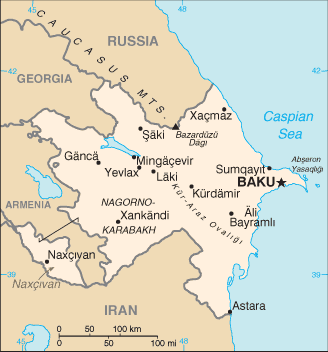Azerbaijan


Continent – Asia
Region – Western Asia
Size – 86,600 km²
Geography – Mostly flat, mountainous north
Language – Azerbaijani, Turkish, Russian, Armenian
Religion – 93.4% Islam, 2.5% Russian Orthodox, 2.3% Armenian Orthodox
Monetary Unit – Monat
Natural Resources – petroleum, natural gas, iron ore, nonferrous metals, bauxite
Agriculture – cotton, grain, rice, grapes, fruit, vegetables, tea, tobacco; cattle, pigs, sheep, goats
Industry – petroleum and natural gas, petroleum products, oilfield equipment; steel, iron ore; cement; chemicals and petrochemicals; textiles

Neighbouring Countries – Russia, Georgia, Armenia, Iran
Population – 9,686,210 (2014)
Population Growth Rate – 0.7%
Average Life Expectancy – 63.9
Capital City – Baku (population 2,122,300)
Highest Mountain – Bazarduzu Dagi (4,485 m)
Longest River – Kura (900 km – in Azerbaijan)
Climate – Hot summers 21°C to 33°C and cold winters 0°C to 12°C
North – warm summers 14°C to 34°C and cold snowy winters -9°C to 10°C
Yearly Rainfall – 15 cm approx, north 30cm approx
Plant Life – 4,500 species
Animal Life – 106 mammal species including cattle, horse, goat, mouflon, gazelle, 52 reptile species
Bird Life – 363 bird species including golden eagle
Aquatic Life – 97 fish species including salmon, sturgeon, beluga. aspius, chalcalburnus, eel
Harvard Reference for this page:
Heather Y Wheeler. (2015). Azerbaijan. Available: https://www.naturalhistoryonthenet.com/Facts_Figures/Country_Facts/azerbaijan.htm. Last accessed Monday, July 18, 2016
Facts and Figures Pages
